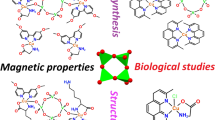Abstract
Electron paramagnetic resonance (EPR) spectra and X-ray absorption (EXAFS and XANES) data have been recorded for the manganese enzyme aminopeptidase P (AMPP, PepP protein) from Escherichia coli. The biological function of the protein, a tetramer of 50-kDa subunits, is the hydrolysis of N-terminal Xaa-Pro peptide bonds. Activity assays confirm that the enzyme is activated by treatment with Mn2+. The EPR spectrum of Mn2+–activated AMPP at liquid-He temperature is characteristic of an exchange-coupled dinuclear Mn(II) site, the Mn-Mn separation calculated from the zero-field splitting D of the quintet state being 3.5 (±0.1) Å. In the X-ray absorption spectrum of Mn2+–activated AMPP at the Mn K edge, the near-edge features are consistent with octahedrally coordinated Mn atoms in oxidation state +2. EXAFS data, limited to k≤12 Å–1 by traces of Fe in the protein, are consistent with a single coordination shell occupied predominantly by O donor atoms at an average Mn-ligand distance of 2.15 Å, but the possibility of a mixture of O and N donor atoms is not excluded. The Mn-Mn interaction at 3.5 Å is not detected in the EXAFS, probably due to destructive interference from light outer-shell atoms. The biological function, amino acid sequence and metal-ion dependence of E. coli AMPP are closely related to those of human prolidase, an enzyme that specifically cleaves Xaa-Pro dipeptides. Mutations that lead to human prolidase deficiency and clinical symptoms have been identified. Several known inhibitors of prolidase also inhibit AMPP. When these inhibitors are added to Mn2+–activated AMPP, the EPR spectrum and EXAFS remain unchanged. It can be inferred that the inhibitors either do not bind directly to the Mn centres, or substitute for existing Mn ligands without a significant change in donor atoms or coordination geometry. The conclusions from the spectroscopic measurements on AMPP have been verified by, and complement, a recent crystal structure analysis.
Similar content being viewed by others
Author information
Authors and Affiliations
Additional information
Received: 23 December 1997 / Accepted: 22 June 1998
Rights and permissions
About this article
Cite this article
Zhang, L., Crossley, M., Dixon, N. et al. Spectroscopic identification of a dinuclear metal centre in manganese(II)-activated aminopeptidase P from Escherichia coli: implications for human prolidase. JBIC 3, 470–483 (1998). https://doi.org/10.1007/s007750050257
Issue Date:
DOI: https://doi.org/10.1007/s007750050257




